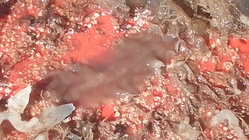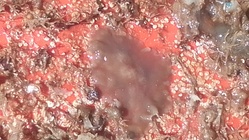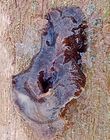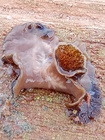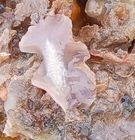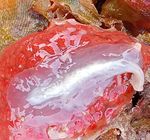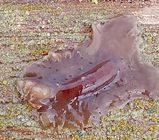WoRMS taxon details
Polycladida
2853 (urn:lsid:marinespecies.org:taxname:2853)
Lang, 1884 [viz. Faubel 1983/1984]
accepted
Order
marine, brackish, fresh
Not documented
Tyler, S., Artois, T.; Schilling, S.; Hooge, M.; Bush, L.F. (eds) (2006-2024). World List of turbellarian worms: Acoelomorpha, Catenulida, Rhabditophora. Polycladida. Accessed through: World Register of Marine Species at: https://www.marinespecies.org/aphia.php?p=taxdetails&id=2853 on 2024-07-26
Date
action
by
2004-12-21 15:54:05Z
created
db_admin
![]() The webpage text is licensed under a Creative Commons Attribution 4.0 License
The webpage text is licensed under a Creative Commons Attribution 4.0 License
taxonomy source
Bahia, J.; Padula, V.; Schrödl, M. (2017). Polycladida phylogeny and evolution: integrating evidence from 28S rDNA and morphology. <em>Organisms Diversity & Evolution.</em> 17(3): 653-678., available online at https://doi.org/10.1007/s13127-017-0327-5 [details] Available for editors  [request]
[request]
basis of record Schockaert, E. R.; Jouk, P. E. H.; Martens, P. M. (1989). Free-living Plathelminthes from the Belgian coast and adjacent areas. <em>In: Wouters, K.; Baert, L. (Ed.) (1989). Proceedings of the Symposium Invertebrates of Belgium.</em> pp. 19-25. (look up in IMIS) [details]
basis of record Faubel, A. (1984). The Polycladida, Turbellaria; Proposal and establishment of a new system. Part 2. The Cotylea. <em>Mitteilungen aus dem Hamburgischen Zoologischen Museum und Institut.</em> 81: 189-259. [details] Available for editors [request]
[request]
basis of record Faubel, A. (1983). The Polycladida, Turbellaria - Proposal and estalishment of a new system Part I. The Acotylea. <em>Mitteilungen aus dem Hamburgischen Zoologischen Museum und Institut.</em> 80: 17-121. [details] Available for editors [request]
[request]
additional source Aguado, M. T.; Noreña, C.; Alcaraz, L.; Marquina, D.; Brusa, F.; Damborenea, C.; Almon, B.; Bleidorn, C.; Grande, C. (2017). Phylogeny of Polycladida (Platyhelminthes) based on mtDNA data. <em>Organisms Diversity & Evolution.</em> 17(4): 767-778., available online at https://www.researchgate.net/publication/320044928_Phylogeny_of_Polycladida_Platyhelminthes_based_on_mtDNA_data [details]
additional source Kenny, N. J.; Noreña, C.; Damborenea, C.; Grande, C. (2018). Probing recalcitrant problems in polyclad evolution and systematics with novel mitochondrial genome resources. <em>Genomics.</em> , available online at https://doi.org/10.1016/j.ygeno.2018.02.009 [details]
additional source Litvaitis, M. K.; Bolaños, D. M.; Quiroga, S. Y. (2019). Systematic congruence in Polycladida (Platyhelminthes, Rhabditophora): are DNA and morphology telling the same story?. <em>Zoological Journal of the Linnean Society.</em> , available online at https://doi.org/10.1093/zoolinnean/zlz007 [details] Available for editors [request]
[request]
additional source Dittmann, I. L.; Cuadrado, D.; Aguado, M. T.; Noreña, C.; Egger, B. (2019). Polyclad phylogeny persists to be problematic. <em>Organisms Diversity & Evolution.</em> 19(4): 585-608., available online at https://doi.org/10.1007/s13127-019-00415-1 [details] Available for editors [request]
[request]
status source Dittmann, I. L.; Cuadrado, D.; Aguado, M. T.; Noreña, C.; Egger, B. (2019). Polyclad phylogeny persists to be problematic. <em>Organisms Diversity & Evolution.</em> 19(4): 585-608., available online at https://doi.org/10.1007/s13127-019-00415-1 [details] Available for editors [request]
[request]
basis of record Schockaert, E. R.; Jouk, P. E. H.; Martens, P. M. (1989). Free-living Plathelminthes from the Belgian coast and adjacent areas. <em>In: Wouters, K.; Baert, L. (Ed.) (1989). Proceedings of the Symposium Invertebrates of Belgium.</em> pp. 19-25. (look up in IMIS) [details]
basis of record Faubel, A. (1984). The Polycladida, Turbellaria; Proposal and establishment of a new system. Part 2. The Cotylea. <em>Mitteilungen aus dem Hamburgischen Zoologischen Museum und Institut.</em> 81: 189-259. [details] Available for editors
basis of record Faubel, A. (1983). The Polycladida, Turbellaria - Proposal and estalishment of a new system Part I. The Acotylea. <em>Mitteilungen aus dem Hamburgischen Zoologischen Museum und Institut.</em> 80: 17-121. [details] Available for editors
additional source Aguado, M. T.; Noreña, C.; Alcaraz, L.; Marquina, D.; Brusa, F.; Damborenea, C.; Almon, B.; Bleidorn, C.; Grande, C. (2017). Phylogeny of Polycladida (Platyhelminthes) based on mtDNA data. <em>Organisms Diversity & Evolution.</em> 17(4): 767-778., available online at https://www.researchgate.net/publication/320044928_Phylogeny_of_Polycladida_Platyhelminthes_based_on_mtDNA_data [details]
additional source Kenny, N. J.; Noreña, C.; Damborenea, C.; Grande, C. (2018). Probing recalcitrant problems in polyclad evolution and systematics with novel mitochondrial genome resources. <em>Genomics.</em> , available online at https://doi.org/10.1016/j.ygeno.2018.02.009 [details]
additional source Litvaitis, M. K.; Bolaños, D. M.; Quiroga, S. Y. (2019). Systematic congruence in Polycladida (Platyhelminthes, Rhabditophora): are DNA and morphology telling the same story?. <em>Zoological Journal of the Linnean Society.</em> , available online at https://doi.org/10.1093/zoolinnean/zlz007 [details] Available for editors
additional source Dittmann, I. L.; Cuadrado, D.; Aguado, M. T.; Noreña, C.; Egger, B. (2019). Polyclad phylogeny persists to be problematic. <em>Organisms Diversity & Evolution.</em> 19(4): 585-608., available online at https://doi.org/10.1007/s13127-019-00415-1 [details] Available for editors
status source Dittmann, I. L.; Cuadrado, D.; Aguado, M. T.; Noreña, C.; Egger, B. (2019). Polyclad phylogeny persists to be problematic. <em>Organisms Diversity & Evolution.</em> 19(4): 585-608., available online at https://doi.org/10.1007/s13127-019-00415-1 [details] Available for editors
 Present
Present  Inaccurate
Inaccurate  Introduced: alien
Introduced: alien  Containing type locality
Containing type locality
From editor or global species database
Classification The classification used here is a compromise between the more traditional taxonomy of Neodermata vs. the turbellarians. Yet it reflects the fact that Neodermata is within free-living flatworms (i.e. turbellaria are paraphyletic). It mentions all traditional taxa that are found in phylogenetic studies (e.g. Laumer et al., 2015). Many of the "in-between" higher level taxa (such as Trepaxonemata etc.) are no longer in WoRMS (probably more user friendly that way). This also means an asymmetry between turbellarians (nine ordines) and Neodermata (superclass with three classes). [details]
